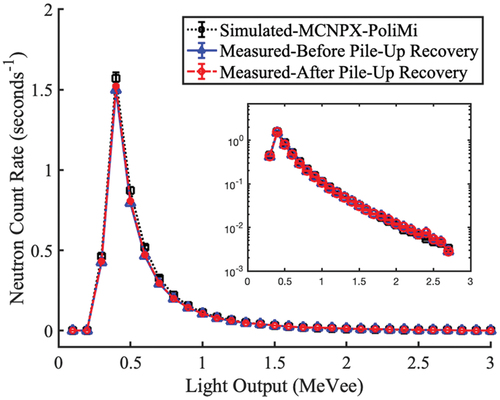 ?Mathematical formulae have been encoded as MathML and are displayed in this HTML version using MathJax in order to improve their display. Uncheck the box to turn MathJax off. This feature requires Javascript. Click on a formula to zoom.
?Mathematical formulae have been encoded as MathML and are displayed in this HTML version using MathJax in order to improve their display. Uncheck the box to turn MathJax off. This feature requires Javascript. Click on a formula to zoom.Abstract
High-energy photon interrogation is a nondestructive technique that is used to detect special nuclear materials and characterize nuclear waste. The development of such systems is complex and requires Monte Carlo simulations to optimize system performance. Monte Carlo simulations rely on various scattering, absorption, and photonuclear cross-section data. While the scattering and absorption cross-section data have been extensively studied and validated with experiments, the results obtained from photonuclear simulations are often found to underpredict measured results, indicating uncertainties in the photonuclear cross sections themselves. Thus, there is a need for new measured results that can be used to quantify underpredictions in simulations using photonuclear cross-section data. In the present work, we interrogated depleted uranium with a 9-MV electron linac and detected photoneutrons with trans-stilbene organic scintillators. The measurement of photoneutrons with organic scintillators is challenging due to the presence of the intense photon flux, which causes issues such as pulse pile-up, detector saturation, and poor signal-to-background ratio. To mitigate these challenges, we used iron and polyethylene shielding of varying thicknesses around the depleted uranium target and a neural network–based digital pulse processing algorithm to recover neutron and photon information from piled-up events. Our goal was to compare the measured photoneutron count rate with the simulated rate obtained using the MCNPX-PoliMi transport code. For a light output window of 0.28 to 2.67 MeVee (1.66- to 6.85-MeV proton recoil energy), we found that the simulated count rate obtained using the ENDF/B-VII photonuclear cross-section library underpredicts the measured rate by 32.8% 3.2%. Additionally, we compared the simulated and measured photoneutron light output distributions. For the least thicknesses of shielding, the simulation was found to underpredict measurements in the 0.70- to 2.67-MeVee light output window. For the greatest thicknesses of shielding, the simulation was found to underpredict the measurement across the entire light output window of 0.28 to 2.67 MeVee.
I. INTRODUCTION
Active interrogation using high-energy photons is a nondestructive assay technique that is used to detect special nuclear materials (SNMs)[Citation1–3] and characterize nuclear waste.[Citation4,Citation5] The development of high-energy photon interrogation systems is complex and requires Monte Carlo simulations to optimize system performance for a given application. Monte Carlo simulations rely on various scattering, absorption, and photonuclear cross-section data. The scattering and absorption cross-section data for neutrons and photons have been extensively studied and validated with experiments because of their importance in nuclear reactor and radiation shielding simulations. However, photonuclear cross sections are not extensively studied and lack the desired validation with measured results.[Citation6] The results obtained from photonuclear simulations are found to underpredict measured results,[Citation7] indicating uncertainties in the cross sections themselves.
Most recently, Sari performed characterization of photoneutron fluxes emitted by a linac in the 4- to 20-MeV energy range using the MCNPX transport code.[Citation8] Sari identified three sources of error that could potentially be the cause of unreliable photoneutron fluxes. One of the identified errors is the lack of knowledge of photoneutron yield both near the reaction energy threshold and at the maximum of the cross-section curve.
In a research project coordinated by the International Atomic Energy Agency, Varlamov performed a reliability study of photonuclear cross-section data obtained by Lawrence Livermore National Laboratory in the United States and Saclay Laboratory in France.[Citation9] Varlamov identified disagreements between data from two laboratories for partial reaction cross sections. This disagreement results from the different photoneutron multiplicity sorting methods used by the two laboratories. Noticeable uncertainties were reported in the evaluated photonuclear cross-section data, which indicate a need for new measured results that can be used to make comparative studies with existing Monte Carlo codes. The measured results presented in the present paper provides a quantitative assessment of the underprediction in the photoneutron count rates obtained by Monte Carlo codes.
The measurement of the photoneutron yield from a target is challenging because of the presence of the intense photon flux, which causes measurement issues such as pulse pile-up, detector saturation, and poor signal-to-background ratio. The pulse pile-up further complicates the measurement because if piled-up signals are not eliminated, they can cause misclassification of the data, and upon elimination of piled-up events, there is loss of information. In the present work, we interrogated a depleted uranium target in various shielded configurations, which reduces the overall radiation flux incident on the detectors and used a neural network–based algorithm to recover information from piled-up signals. Photoneutrons from depleted uranium were studied because depleted uranium is a SNM that is commonly used to test high-energy photon interrogation systems. Such interrogation systems have application in nuclear waste characterization and detection of hidden SNM in cargo containers.
The interrogation of depleted uranium was performed using bremsstrahlung radiation from a 9-MV electron linac. Our goal was to measure the photoneutron count rate from depleted uranium and compare the measured rate with the simulated rate obtained using the MCNPX-PoliMi transport code. The findings from this work provide new measured results that can help improve photonuclear cross-section data for uranium, which in turn will enhance simulation capabilities with existing Monte Carlo codes.
The structure of this paper is as follows. A detailed description of the experimental setup is provided followed by a description of the steps involved in the simulation process. We then provide an overview of all steps used in the analysis of the measured and simulated data. A comparative study between the measured and the simulated results is performed in Sec. IV. We conclude our findings with a discussion of discrepancies that exist between measured and simulated results and provide recommendations for future work.
II. EXPERIMENTAL SETUP AND MCNPX-PoliMi METHODOLOGY
A 5.23-cm depleted uranium cube (99.7 wt% 238U and 0.3 wt% 235U) was interrogated with bremsstrahlung radiation from an electron linac. The linac at the University of Michigan is a Varex M9 linatron,[Citation10] which is currently operating at a repetition rate of approximately 44 Hz and has a pulse length of approximately 4 . The bremsstrahlung radiation is collimated using a primary collimator and a secondary collimator. The primary collimator consists of lead backed with tungsten and has a beam spot size of 25 cm. The lead is 83 cm in diameter and 28 cm in thickness whereas tungsten is 48 cm in diameter and 11 cm in thickness. The secondary collimator consists of lead, which is 74 cm square and 41 cm thick. The beam spot size is reduced from 25 to 5.08 cm at the exit of the secondary collimator.
The depleted uranium target was placed 27 cm from the secondary collimator opening. At this location, the beam spot size is large enough to irradiate the entire surface area of the cube, which is desired to maximize photoneutron production in depleted uranium. Four trans-stilbene organic scintillation crystals 5.08 cm in length and 5.08 cm in diameter from Inrad Optics[Citation11] were used for fast neutron detection. The trans-stilbene crystals were coupled to 5.08-cm-diameter photomultiplier tubes from ET Enterprises.[Citation12] Scintillation pulses were digitized using a V1730, 14-bit, 500 MS/s digitizer from CAEN.[Citation13]
Trans-stilbene is a state-of-the-art scintillator that is sensitive to gamma rays and fast neutrons. A layered lead-tin-copper shield cave was used to reduce the photon flux incident on the detectors. The front and sides of the shield cave have 10.16-cm-thick lead. There was 5.08 cm of lead on the top and the bottom of the shield cave. The tin and copper used in the shield cave were 0.64 cm thick and provide shielding to and
X-rays, which are produced in lead because of high-energy photon absorption.[Citation14] The front of the lead-tin-copper shield cave was placed 4 m from the edge of the depleted uranium cube. Additionally, the detectors were placed off-axis from the bremsstrahlung beam centerline. The photograph of the experimental setup is shown in .
Fig. 1. (a) Photographs of the experimental setup for the interrogation of depleted uranium and (b) screenshot of the detailed geometry of the laboratory space defined in MCNPX-PoliMi.
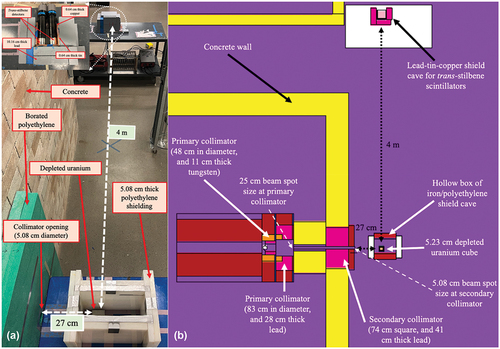
The interrogation of depleted uranium was performed in various iron and polyethylene shielded configurations. Both iron shielding and polyethylene shielding were hollow boxes of varying wall thicknesses. The iron wall thickness extended up to 6.35 cm, and the polyethylene wall thickness extended up to 15.24 cm. The distance between the depleted uranium and the collimator opening was constant, i.e., 27 cm, across all configurations. Both iron shielding and polyethylene shielding around depleted uranium were studied because iron primarily attenuates bremsstrahlung photons, which reduces photoneutron production in the target, whereas polyethylene primarily attenuates the produced photoneutrons. All measurements with depleted uranium were performed for 1 h. Additionally, a 1-h measurement was performed with no target present to measure the passive neutron background and the active neutron room return. This active room return is caused by photoneutrons produced due to () reactions occurring in the collimator and other high-Z surrounding materials, which then eventually scatter into the detectors. This measurement with no target is referred to as the active background measurement.
The measurement was simulated with the MCNPX-PoliMi transport code[Citation15,Citation16] using the ENDF/B-VII photonuclear cross-section library.[Citation7] MCNPX-PoliMi is a well-established particle transport code that has been validated with experiments.[Citation17,Citation18] The ENDF/B-VII library was selected because it contains updated photonuclear cross sections for 163 isotopes up to 140-MeV photon energies.[Citation7] The evaluations of these cross sections were performed using methodology and modeling tools developed at Los Alamos National Laboratory in collaboration with the International Atomic Energy Agency.[Citation19]
MCNPX-PoliMi simulation was performed in a detailed geometry that included structural components of the linac; primary and secondary collimation of bremsstrahlung photons; beam dump; and details of the laboratory space, such as ceiling, floor, and support columns. The screenshot of the geometry is shown in . This developed MCNPX-PoliMi model was validated before performing photonuclear simulation. A 252Cf spontaneous fission source was used for validation purposes, and the simulated results were compared with the measured results that were obtained using the exact same detector setup described above.
The photonuclear simulation was performed in three steps: (1) electron simulation, (2) photoneutron simulation, and (3) detector response simulation. For the electron simulation, 10-MeV monoenergetic electrons were modeled in MCNPX-PoliMi. The 10-MeV energy of the electron is based on a previous beam quality measurement performed at the University of Michigan.[Citation20] The electron source was defined as a point source at a radial distance of 0.05 cm from the X-ray converter target. The source electrons were directed in the forward direction, i.e., 0 deg with respect to the radial distance. A photon current tally (MCNPX type 1 tally) was used to obtain a bremsstrahlung spectrum at the secondary collimator opening. This photon current tally was cosine-binned between 0 to 90 deg and 90 to 180 deg; the angle of cosine in MCNPX-PoliMi is defined with respect to a vector normal to the surface in the outward direction. The tally result in the 0- to 90-deg bin provided the energy spectrum of bremsstrahlung photons exiting the secondary collimator.
For the photoneutron simulation, a photon source was defined as a monodirectional disk source parallel to the photon beam direction. The radius of the disk source was set to 2.54 cm, which corresponds to a beam spot size of 5.08 cm. The emission probability as a function of bremsstrahlung energy was defined using the photon current tally result in the 0- to 90-deg bin from the electron simulation. It was assumed that backscattered photons would not contribute to photoneutron production. This assumption is valid because in the 4- to 10-MeV energy region, the photon current tally result in the 90- to 180-deg bin was six orders of magnitude lower than the tally result in the 0- to 90-deg bin. Additionally, the energy spectrum of photons in the 90- to 180-deg bin was softer relative to photons in the 0- to 90-deg bin. Hence, backscattered photons would have negligible contribution to photoneutron production in uranium, and therefore, they were not included in the source definition. We tallied photoneutrons exiting the face of depleted uranium toward the detector array using a cosine-binned and an energy-binned neutron current tally (MCNPX type 1 tally). The cosine bin widths were set to 5 deg, and the energy bin widths were set to 0.1 MeV.
The energy-binned tally results in the 0-, 5-, 10-, … ., 90-deg cosine bins were used to define the photoneutron source term for the detector response simulation. The energy-binned tally results in the 95-, 100-, … ., 180-deg cosine bins were not used in the source definition because of their low emission probabilities and soft energy spectrum. Additionally, photoneutrons from other faces of the depleted uranium target were not included because these neutrons will scatter into the detectors through surrounding materials, which will reduce their kinetic energy. The large source-to-detector distance, i.e., >4 m, reduces the chance of these photoneutrons constituting a voltage signal above the detection threshold. The photoneutron source was defined as a planar source at the face of depleted uranium that is facing toward the detector array. During the detector response simulation, a particle collision file was generated, which included photoneutron collision information in all four trans-stilbene detectors.
III. DATA ANALYSIS
In trans-stilbene organic scintillation detectors, photons are detected through electron recoil (Compton scatter), and fast neutrons are detected through proton recoil (elastic scatter). Traditionally, the discrimination between photons and neutrons is done with a pulse shape discrimination (PSD) analysis such as the charge integration. This method () compares the tail and the total integrals of the scintillation pulse to a discrimination line to classify each detected event. For piled-up pulses, the tail integral of the scintillation pulse is artificially increased, resulting in the misclassification of piled-up events as neutrons. During photon interrogation, such piled-up events are due to the presence of the intense bremsstrahlung radiation. To mitigate the effect of pulse pile-up, a previously developed artificial neural network (ANN) system[Citation21] was used to classify scintillation pulses as neutrons and photons and recover neutron and photon information from piled-up events.
Fig. 2. (a) Traditional charge integration method for PSD analysis (represented scintillation events are detected voltage pulses when particles deposit 2-MeV energy) and (b) neutron and photon tail and total pulse integrals for a 252Cf spontaneous fission source (measured with a 5.08-cm-long and 5.08-cm-diameter trans-stilbene detector).
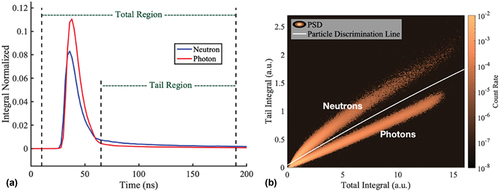
The developed ANN system was trained in a supervised fashion using high-confidence neutron and photon pulses acquired through a time-of-flight (TOF) measurement. To establish ground truth training data for pile-up recovery, piled-up events were synthesized using the extracted high-confidence neutron and photon pulses. During the validation of the developed ANN system, an overall classification accuracy of 99.5% was achieved on the test data. These test data were prelabeled, and the ANN system classifications were compared with ground truth classifications.[Citation21] Additionally, the performance of the ANN system in the intense radiation environment was demonstrated through an active 252Cf measurement. In this measurement, fission neutrons from the 252Cf source were measured in the presence of the intense bremsstrahlung radiation from the linac.
As stated earlier, the Varex M9 linac is operating in pulsed mode. We performed time gating to separate scintillation pulses that occurred during and in-between linac pulses. Scintillation pulses that arrived during the linac pulse were processed with the ANN system. This time gating allowed us to discriminate prompt photoneutrons from delayed fission neutrons, which are emitted through decay of photofission fragments. Additionally, all data were processed with a lower light output threshold of 0.28 MeVee and an upper threshold of 2.67 MeVee (mega-electron-volt electron equivalent, i.e., the amount of light created by a photon energy deposition in mega-electron-volts). This light output window corresponds to a proton recoil energy of 1.66 to 6.85 MeV.
MCNPX-PoliMi provides particle collision information in an output file. This information includes particle type (neutron, photon, or electron), type of interaction, atomic and mass numbers of the element with which the particle interacts, and energy of the particle before and after collision. The collision file from MCNPX-PoliMi was processed with a postprocessing algorithm, i.e., MPPost.[Citation22] The Birks function,[Citation23]
was used to convert energy deposited by photoneutrons to light output. In EquationEq. (1)(1)
(1) ,
= light output in units of MeVee, dE/dx = particle stopping power in the trans-stilbene material, and
and
= fitted coefficients that are obtained from the characterization performed by Shin and colleagues.[Citation24] The MPPost processed data were scaled to the photoneutron count rate using
where = peak linac current (97.2
);
= elementary charge;
= duty factor of the linac (0.02%). The term
represents the total bremsstrahlung photons produced per incident electron, which is the sum of the energy-binned photon current tally from the electron simulation. The sum of the cosine- and energy-binned neutron tally from step 2 of the simulation (photoneutron simulation) provided the total photoneutrons emitted from depleted uranium per incident bremsstrahlung photon, i.e.,
. The term
represents the total neutrons detected in trans-stilbene detectors per emitted photoneutron, which was calculated by MPPost.
In EquationEq. (2)(2)
(2) ,
and
are the sources of systematic errors. The average repetition rate of the linac was measured to be 44.15 Hz with a standard deviation of 0.09 Hz. This deviation in the linac repetition rate was accounted for in the duty factor and the scaled photoneutron count rate. The uncertainty associated with the peak linac current, i.e.,
was assumed to be 1%, which was propagated in the scaled photoneutron count rate. The remaining terms in EquationEq. (2)
(2)
(2) are the sources of statistical errors. A large number of source particles were sampled during each step of the photonuclear simulation such that the statistical uncertainty was less than 0.001%.
IV. RESULTS AND DISCUSSION
IV.A. Breakdown of Scintillation Pulses
shows the breakdown of scintillation pulses from the trans-stilbene organic scintillators during interrogation of depleted uranium in various shielded configurations. The developed ANN system broadly categorized voltage pulses into three broad categories: singles, recoverable piled-up events, and unclassifiable piled-up events. The singles and recoverable piled-up categories were further classified as neutrons and photons whereas unclassifiable events were eliminated. These unclassifiable piled-up events included triple/quadruple pile-ups and voltage pulses that were extremely noisy. The noisy pulses constituted most unclassifiable piled-up events, and the ANN system was unable to classify them as neutrons and photons with confidence.
Fig. 3. Breakdown of scintillation pulses from the trans-stilbene detectors during interrogation of depleted uranium: (a) iron shielded configurations and (b) polyethylene shielded configurations.
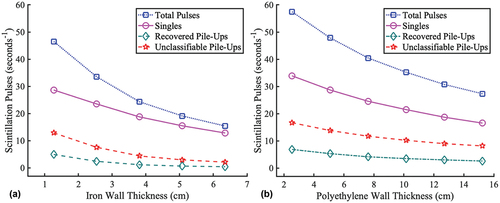
For both iron and polyethylene shielded configurations, the total scintillation pulses decreased with an increase in the shield wall thickness. This decreasing trend is due to the attenuation of bremsstrahlung photons by iron and the moderation of neutrons by polyethylene. The percentage of voltage pulses categorized as singles increased with an increase in iron wall thickness, i.e., from 62% to 83%, This increase in the number of clean signals is due to the attenuation of photons, which reduces pulse pile-up. For the polyethylene shielded configurations, the singles constituted an average of 60% of the total scintillation pulses across all thicknesses. This nearly constant percentage of singles is because a low-Z material like polyethylene has a small effect on the bremsstrahlung radiation.
show the tail and total integrals of neutrons and photons detected during linac active interrogation of depleted uranium shielded in the least and greatest thicknesses of iron and polyethylene with and without the piled-up events. The results shown in demonstrate the ANN ability to accurately identify singles, and we observe a good separation between neutrons and photons without any piled-up events in the PSD plots.
Fig. 4. Neutron and photon tail and total pulse integrals for depleted uranium shielded in (a) 1.27 cm of iron (with pile-up events), (b) 1.27 cm of iron (without pile-up events), (c) 6.35 cm of iron (with pile-up events), and (d) 6.35 cm of iron (without pile-up events).
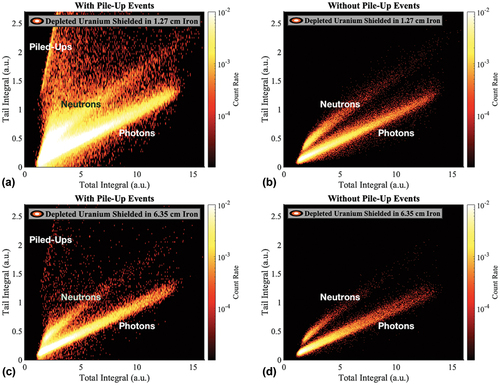
Fig. 5. Neutron and photon tail and total pulse integrals for depleted uranium shielded in (a) 2.54 cm of polyethylene (with pile-up events), (b) 2.54 cm of polyethylene (without pile-up events), (c) 15.24 cm of polyethylene (with pile-up events), and (d) 15.24 cm of polyethylene (without pile-up events).

IV.B. Validation of the MCNPX-PoliMi Transport Code
We performed a passive 252Cf measurement with the same detector setup that was used for the detection of photoneutrons from depleted uranium. The source was placed 4 m from the front of the lead-tin-copper shield cave (same distance as depleted uranium and the front of the shield cave) and was placed in a hollow box of iron, which had a wall thickness of 1.27 cm. This measurement was simulated with the exact same MCNPX-PoliMi model that was later used to simulate photonuclear reactions in depleted uranium.
shows the measured and simulated neutron light output distributions for a 252Cf spontaneous fission source. The neutron count rates before and after recovery of piled-up events are statistically identical, which is expected due to the low activity of the source, i.e., 817.26 40.86
on September 16, 2022, and a large source-to-detector distance (>4 m). Additionally, only 1% of the total scintillation pulses was eliminated due to unclassifiable events. The simulation agrees with the measurement within 6.1%
1.2%. This result demonstrates the accuracy of the particle transport code, validates the absorption and scattering cross sections for different materials used in the simulation, and validates modeling of the trans-stilbene detector response using MPPost.
IV.C. Photoneutron Count Rate
shows the bremsstrahlung photon spectrum at the exit of the secondary collimator obtained from the electron simulation. The ENDF/B-VII photonuclear cross-section data for (), (
), and (
) reactions are also represented in . The Q value for (
) photonuclear reactions in 238U is 6.2 MeV, and the threshold for (
) reactions is 5.5 MeV. There are no photoneutrons from the (
) reactions as the end-point energy of the bremsstrahlung radiation is less than the reaction threshold energy in 238U
(the Q value for (
) in 238U is 11.3 MeV). Approximately 9% of the total bremsstrahlung spectrum is emitted with energies greater than 5.5 MeV, and therefore, only a fraction of emitted photons induces photonuclear reactions in the depleted uranium target. The rest of the bremsstrahlung photons do not contribute to photoneutron production; however, they constitute an intense photon background and cause pulse pile-up issues in trans-stilbene detectors.
Fig. 7. ENDF/B-VII photonuclear cross-section data[Citation7] for 238U superimposed with the bremsstrahlung photon spectrum.
![Fig. 7. ENDF/B-VII photonuclear cross-section data[Citation7] for 238U superimposed with the bremsstrahlung photon spectrum.](/cms/asset/1933ebba-9853-48bc-8bde-d86780bc913b/unse_a_2238169_f0007_oc.jpg)
shows the measured and the simulated photoneutron count rates for depleted uranium shielded in various thicknesses of iron. The photonuclear simulation was performed using the validated MCNPX-PoliMi model described in Sec. IV.B. Both measured and simulated count rates decreased with an increase in iron wall thickness. This decreasing trend is expected because the attenuation of bremsstrahlung radiation caused by iron reduces the () and (
) photonuclear reaction rates in depleted uranium, which reduces the production of photoneutrons. shows the measured and the simulated photoneutron count rates for depleted uranium shielded in various polyethylene configurations. We again observed a decreasing trend in the measured and the simulated count rates, which is expected because polyethylene is a neutron moderator, and therefore, it can reduce the neutron energy below detection thresholds.
Fig. 8. Simulated and active background subtracted photoneutron count rates: (a) depleted uranium shielded in varying thicknesses of iron and (b) depleted uranium shielded in varying thicknesses of polyethylene. (Error bars are from Poisson counting statistics and are represented within one standard deviation).
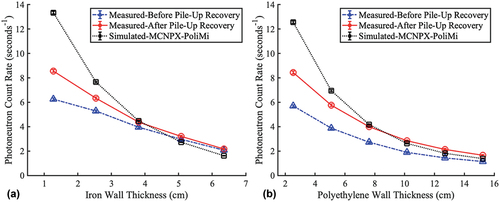
The pile-up events were processed with the ANN pile-up recovery to restore neutron information. For the 1.27-cm-thick iron configuration, pile-up recovery constituted nearly 27% of the total photoneutron count rate. The percentage of recovered neutrons was reduced to 5% for the 6.35-cm-thick iron configuration. This reduced recovery in neutron information is due to reduced pulse pile-up. The simulated photoneutron count rate for this minimally piled-up affected iron configuration was found to underpredict the measured count rate by 25.9% 3.3%. This thickest iron configuration, which has the highest percentage of collected data classified as singles, establishes a reference value to quantify the discrepancy between measurement and simulation. For the 1.27- and 2.54-cm-thick iron configurations, the discrepancy between the measured and the simulated photoneutron count rates improved after pile-up recovery; however, the simulated rate is overpredicting the measured rate, which is due to the information that is lost to unclassifiable piled-up events.
For all six polyethylene configurations, pile-up recovery constituted an average of 32% of the total photoneutron count rate. For the 2.54-, 5.08-, and 7.62-cm-thick polyethylene configurations, the simulated rate is found to overpredict the measured rate (after pile-up recovery). We observed that the discrepancy between simulation and measurement reaches an asymptote with increasing polyethylene wall thickness. For the 12.70- and 15.24-cm-thick configurations, the simulated count rate underpredicted the measured rate by 14.7% 3.3% and 16.9%
3.9%, respectively. This underprediction is consistent with the reference value obtained from the iron shielded configurations.
In 2015, Frankl and Macian-Juan performed a photonuclear benchmark study using MCNPX with the ENDF/B-VII cross-section library.[Citation25] The authors used measurement data that were obtained by Barber and George in 1959.[Citation26] For a 0.98-cm-thick natural uranium target interrogated with a 11.5-MV electron linac, Frankl and Macian-Juan found that the simulated count rate underpredicts the measured rate by 8.7% 15.1%. In the present work, the depleted uranium target is 5.23 cm thick and interrogated with a 9-MV linac. The reference underprediction value obtained from the maximum iron configuration is 25.9%
3.3%. This underprediction is consistent with the Frankl and Macian-Juan results. However, because of huge uncertainty in the measured result by Barber and George, it cannot be concluded that the underprediction obtained in the present study agrees with 8.7%
15.1%. The ENDF/B-VII library provided an integral validation of the photonuclear cross section for 235U.[7] This validation found that the discrepancy between measurement and simulation can vary between 20% to 30%. Our reference underprediction lies within the 20% to 30% range, which provides confidence in the obtained result.
IV.D. Photoneutron Light Output Distributions
shows the normalized photoneutron light output distribution for depleted uranium shielded in 2.54-cm-thick iron and 2.54-cm-thick polyethylene configurations. For both shielded configurations, the measured distributions have the same shape before and after recovery of piled-up events. This same shape implies that pile-up recovery provided an efficiency boost for neutron detection; i.e., pile-up recovery increased the photoneutron counts thereby providing a higher neutron detection efficiency. Additionally, this result helps build confidence in the recovery of piled-up events through the ANN system.
Fig. 9. Normalized photoneutron light output distributions for depleted uranium shielded in (a) 2.54-cm-thick iron and (b) 2.54-cm-thick polyethylene. (Error bars are represented within one standard deviation).
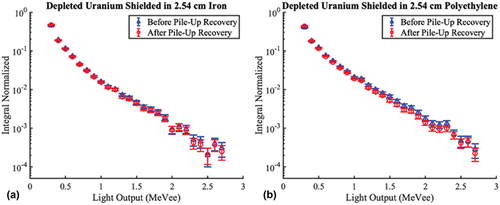
shows the measured and the simulated photoneutron light output distributions for the least and the greatest thicknesses of iron and polyethylene tested in this work. For the least thicknesses of shielding, i.e., 1.27 cm for iron and 2.54 cm for polyethylene, the simulated count rate overpredicted the measured count rate in the 0.28- to 0.60-MeVee light output window. This overprediction is due to the information that is lost to unclassifiable piled-up events. Nearly 75% of these unclassifiable piled-up events were voltage signals that were noisy and had a small amplitude, i.e., less than 0.6 MeVee. The simulation was found to underpredict the measurement in the 0.70- to 2.67-MeVee light output window by an average of 35.4% 2.1%.
Fig. 10. Simulated and active background subtracted photoneutron light output distributions for the least and greatest thicknesses of (a) iron shielding and (b) polyethylene shielding. (Error bars are from Poisson counting statistics and are represented within one standard deviation).

For the greatest thicknesses of shielding, i.e., 6.35 cm for iron and 15.24 cm for polyethylene, the simulation was underpredicting the measured result across the entire light output window of 0.28 to 2.67 MeVee. This underprediction between simulation and measurement is 25.9% 3.3% for the 6.35-cm-thick iron case and 16.9%
3.9% for the 15.24-cm-thick polyethylene case.
The discrepancy between results of the thickest iron and polyethylene shielded configurations is due to the information that is lost to unclassifiable piled-up events. Nearly 14% of the collected data was eliminated from the thickest-iron case while 30% was eliminated from the thickest-polyethylene case. Assuming that the triple and double types of piled-up events contain three and two radiation detections, respectively, and the eliminated data have the same neutron-to-photon ratio as single pulses, the fractional neutrons present in the eliminated data can be estimated. For depleted uranium shielded in 6.35-cm-thick iron and 15.24-cm-thick polyethylene, the measured neutron-to-photon ratios are 0.35 and 0.09, respectively. Using these measured ratios, the neutron fraction is computed using
where = neutron fraction;
= measured neutron-to-photon ratio. The neutron fractions estimated by EquationEq. (3)
(3)
(3) were used to predict the missing photoneutron count rate in the thickest iron and polyethylene shielded configurations. These count rates were 0.22 photoneutron/s for the 6.35-cm-thick iron configuration and 0.43 photoneutron/s for the 15.24-cm-thick polyethylene configuration. These fractional neutrons from the eliminated data were added to the photoneutron count rate after pile-up recovery, and the simulation was found to underpredict the measured result by 32.8%
3.2% for the thickest-iron case and 34.0%
3.3% for the thickest-polyethylene case. These underpredictions obtained after accounting for unclassifiable piled-up events agree with the 35.4%
2.1% value that was obtained from the least thicknesses of iron and polyethylene shielding in the 0.70- to 2.67-MeVee light output window.
V. CONCLUSIONS
We presented new measured results for the photoneutron count rate from depleted uranium interrogated with a 9-MV electron linac. The measurement of photoneutrons is challenging due to the presence of the intense photon flux, which causes pulse pile-up, detector saturation, and poor signal-to-background ratio. These issues were mitigated by introducing iron and polyethylene shielding around depleted uranium and using a neural network–based digital pulse processing algorithm to recover neutron and photon information from piled-up events. The measured photoneutron count rate was compared with the simulated rate that was obtained using the MCNPX-PoliMi transport code with ENDF/B-VII photonuclear cross-section libraries.
For the thickest case of the iron shielding, i.e., 6.35 cm, the effect of pulse pile-up was minimal. This minimally piled-up affected configuration was used to establish a reference value to quantify the discrepancy between measurement and simulation. The MCNPX-PoliMi simulation was found to underpredict the measured photoneutron count rate by 25.9% 3.3%. A significant portion of the collected data, i.e., 14%, was still eliminated due to unclassifiable piled-up events. We further estimated the contribution of unclassifiable piled-up events to the photoneutron count rate using the measured neutron-to-photon ratio from single pulses. After correcting for unclassifiable events, the simulation was found to underpredict measurements by at most 33.8%
3.2%. For the thickest-polyethylene case, i.e., 15.24 cm, after correcting for unclassifiable events, the simulation was found to underpredict the measured result by 34.0%
3.3%. The results obtained from the thickest iron and polyethylene shielded configurations are in good agreement within one standard deviation.
For the least thicknesses of the iron and polyethylene shielded configurations, the discrepancy between simulation and measurement improved after recovering neutron information from piled-up events. For a light output window of 0.70 to 2.67 MeVee, the MCNPX-PoliMi result was found to underpredict the measured photoneutron count rate by an average of 35.4% ± 2.1%. This result obtained from the most piled-up affected configurations is in good agreement with the result obtained from the least piled-up affected configurations. The underestimation by the MCNPX-PoliMi code is primarily caused by underpredicted photonuclear cross-section data for uranium. This result can be concluded because the validation of the MCNPX-PoliMi simulation performed with the 252Cf source yielded good agreement between measurement and simulation; we can be confident that the discrepancy is not due to other cross-section data utilized in the simulation process.
Another cause of this large discrepancy may be the source definitions used in the three-step photonuclear simulation. The electron, bremsstrahlung photon, and photoneutron sources were defined with certain assumptions that are difficult to validate through experiments. Other possible causes of discrepancy include the accuracy of the photoneutron spectrum in energy and angle, and the average prompt neutron yield per photofission.
The developed ANN system is limited to classifying scintillation pulses that have light output values between 0.28 and 2.67 MeVee (1.66- to 6.85-MeV proton recoil energy). This limitation is due to the voltage thresholds applied to the TOF data, which were used to train the ANN system. The classification range of the ANN system must be expanded in the future. The current work further provided a methodology to simulate linac active interrogation measurements using the Monte Carlo code and measure photoneutrons with organic scintillators. The developed methodology can be used to predict photoneutron count rates from other common elements such as plutonium, iron, heavy water, etc.
The comparison of the predicted count rates with measured rates can help improve photonuclear cross-section data for elements of interest in the nuclear community. The Experimental Nuclear Reaction Database (EXFOR) is a repository where the measured results from the current work are being uploaded. The evaluators of the ENDF nuclear library use experimental results from EXFOR to improve cross-section data.
Disclosure Statement
No potential conflict of interest was reported by the author(s).
Additional information
Funding
References
- A. DANAGOULIAN et al., “Prompt Neutrons from Photofission and Its Use in Homeland Security Applications,” Proc. 2010 IEEE Int. Conf. Technologies for Homeland Security (HST 2010), Waltham, Massachusetts, November 8–10, 2010, p. 379, IEEE (2010); http://dx.doi.org/10.1109/THS.2010.5654938.
- B. W. BLACKBURN et al., “Utilization of Actively-Induced, Prompt Radiation Emission for Nonproliferation Applications,” Nucl. Instrum. Methods Phys. Res. Sect. B, 261, 1–2, 341 (2007); http://dx.doi.org/10.1016/j.nimb.2007.04.272.
- A. SARI et al., “Neutron Interrogation of Actinides with a 17 MeV Electron Accelerator and First Results from Photon and Neutron Interrogation Non-Simultaneous Measurements Combination,” Nucl. Instrum. Methods Phys. Res. Sect. B, 312, 30 (2013); http://dx.doi.org/10.1016/j.nimb.2013.06.020.
- A. LYOUSSI et al., “Transuranic Waste Detection by Photon Interrogation and On-Line Delayed Neutron Counting,” Nucl. Instrum. Methods Phys. Res. Sect. B, 160, 280 (2000); http://dx.doi.org/10.1016/S0168-583X(99)00586-8.
- P. M. DIGHE et al., “Delayed Gamma Studies from Photo-Fission of 237Np for Nuclear Waste Characterization,” Ann. Nucl. Energy, 36, 3, 399 (2009); http://dx.doi.org/10.1016/j.anucene.2008.11.035.
- C. ROMANO et al., Proceedings of the Workshop for Applied Nuclear Data (WANDA2020), Washington, D.C., March 3–5, 2020; https://doi.org/10.2172/1649010.
- M. B. CHADWICK et al., “ENDF/B-VII.0: Next Generation Evaluated Nuclear Data Library for Nuclear Science and Technology,” Nucl. Data Sheets, 107, 12, 2931 (2006); http://dx.doi.org/10.1016/j.nds.2006.11.001.
- A. SARI, “Characterization of Photoneutron Fluxes Emitted by Electron Accelerators in the 4–20 MeV Range Using Monte Carlo Codes: A Critical Review,” Appl. Radiat. Isot., 191, 110506 (2023); http://dx.doi.org/10.1016/j.apradiso.2022.110506.
- V. V. VARLAMOV, “Reliability of Photonuclear Data: Various Experiments and Evaluations,” Phys. Part. Nucl., 50, 5, 637 (2019); http://dx.doi.org/10.1134/S1063779619050241.
- “Linatron M9 & M9A Modular High-Energy X-Ray Source,” Varex Imaging.
- “Scintinel Stilbene Single Crystals,” Inrad Optics; https://inradoptics.com/pdfs/datasheets/InradOptics_Datasheet_Stilbene_Final.pdf (current as of Aug. 10, 2022).
- “ET Enterprises 51 mm (2″) Photomultiplier 9214B Series Data Sheet,” E. T. Enterprises; https://et-enterprises.com/products/photomultipliers/product/p9214b-series; (current as of Aug. 11, 2022).
- “CAEN V1730/V1730S 16/8 Channel 14 Bit 500 MS/s Digitizer,” CAEN; https://www.caen.it/products/v1730/ (current as of Aug. 11, 2022).
- R. D. DESLATTES et al., “X-ray Transition Energies: New Approach to a Comprehensive Evaluation,” Rev. Mod. Phys., 75, 1, 35 (2003); http://dx.doi.org/10.1103/RevModPhys.75.35.
- S. A. POZZI, E. PADOVANI, and M. MARSEGUERRA, “MCNP-PoliMi: A Monte-Carlo Code for Correlation Measurements,” Nucl. Instrum. Methods Phys. Res. Sect. A, 513, 3, 550 (2003); http://dx.doi.org/10.1016/j.nima.2003.06.012.
- S. A. POZZI et al., “MCNPX-PoliMi for Nuclear Nonproliferation Applications,” Nucl. Instrum. Methods Phys. Res. Sect. A, 694, 119 (2012); http://dx.doi.org/10.1016/j.nima.2012.07.040.
- S. A. POZZI et al., “Validation of MCNPX-PoliMi Fission Models,” Proc. IEEE Nuclear Science Sympsosium and Medical Imaging Conference Record, Anaheim, California, October 29–November 3, 2012, p. 997, IEEE (2012); http://dx.doi.org/10.1109/NSSMIC.2012.6551256.
- S. D. CLARKE et al., “Verification and Validation of the MCNPX-PoliMi Code for Simulations of Neutron Multiplicity Counting Systems,” Nucl. Instrum. Methods Phys. Res. Sect. A, 700, 135 (2013); http://dx.doi.org/10.1016/j.nima.2012.10.025.
- M. CHADWICK et al., “Handbook on Photonuclear Data for Applications: Cross-Sections and Spectra,” IAEA-TECDOC-1178, International Atomic Energy Agency (2000).
- N. H. BA SUNBUL, “Validation of Ionizing Radiation Acoustic Imaging (iRAI) for 3D Dosimetry,” Dissertation, University of Michigan (2022).
- A. J. JINIA et al., “An Artificial Neural Network System for Photon-Based Active Interrogation Applications,” IEEE Access, 9, 1 (2021); http://dx.doi.org/10.1109/access.2021.3108406.
- E. C. MILLER et al., “MCNPX-PoliMi Post-Processing Algorithm for Detector Response Simulation,” J. Nucl. Mater. Manag., 40, 2, 34 (2012).
- J. B. BIRKS, “Organic Crystal Scintillators,” Theory and Practice of Scintillation Counting, p. 235 (1964); http://dx.doi.org/10.1016/b978-0-08-010472-0.50012-4.
- T. H. SHIN et al., “Measured Neutron Light-Output Response for Trans-Stilbene and Small-Molecule Organic Glass Scintillators,” Nucl. Instrum. Methods Phys. Res. Sect. A, 939, 36 (2019); http://dx.doi.org/10.1016/j.nima.2019.05.036.
- M. FRANKL and R. MACIÁN-JUAN, “Photonuclear Benchmarks of C, Al, Cu, Ta, Pb, and U from the ENDF/B-VII Cross-Section Library ENDF7U Using MCNPX,” Nucl. Sci. Eng., 183, 1, 135 (2016); http://dx.doi.org/10.13182/NSE15-47.
- W. C. BARBER and W. D. GEORGE, “Neutron Yields from Targets Bombarded by Electrons,” Phys. Rev., 116, 6, 1551 (1959); http://dx.doi.org/10.1103/PhysRev.116.1551.

